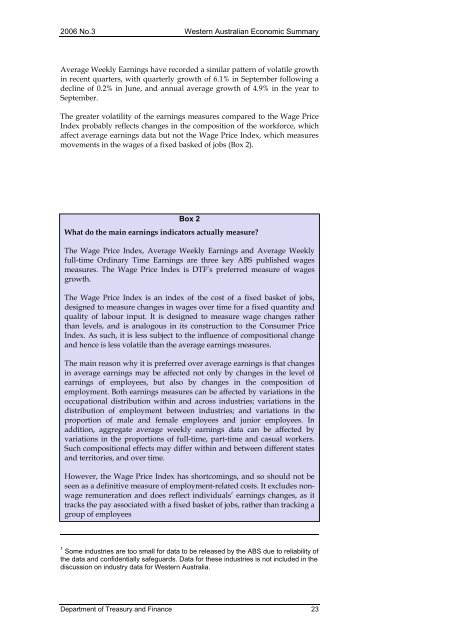No. 3 - Department of Treasury - The Western Australian Government
No. 3 - Department of Treasury - The Western Australian Government
No. 3 - Department of Treasury - The Western Australian Government
Create successful ePaper yourself
Turn your PDF publications into a flip-book with our unique Google optimized e-Paper software.
2006 <strong>No</strong>.3 <strong>Western</strong> <strong>Australian</strong> Economic SummaryAverage Weekly Earnings have recorded a similar pattern <strong>of</strong> volatile growthin recent quarters, with quarterly growth <strong>of</strong> 6.1% in September following adecline <strong>of</strong> 0.2% in June, and annual average growth <strong>of</strong> 4.9% in the year toSeptember.<strong>The</strong> greater volatility <strong>of</strong> the earnings measures compared to the Wage PriceIndex probably reflects changes in the composition <strong>of</strong> the workforce, whichaffect average earnings data but not the Wage Price Index, which measuresmovements in the wages <strong>of</strong> a fixed basked <strong>of</strong> jobs (Box 2).Box 2What do the main earnings indicators actually measure?<strong>The</strong> Wage Price Index, Average Weekly Earnings and Average Weeklyfull-time Ordinary Time Earnings are three key ABS published wagesmeasures. <strong>The</strong> Wage Price Index is DTF’s preferred measure <strong>of</strong> wagesgrowth.<strong>The</strong> Wage Price Index is an index <strong>of</strong> the cost <strong>of</strong> a fixed basket <strong>of</strong> jobs,designed to measure changes in wages over time for a fixed quantity andquality <strong>of</strong> labour input. It is designed to measure wage changes ratherthan levels, and is analogous in its construction to the Consumer PriceIndex. As such, it is less subject to the influence <strong>of</strong> compositional changeand hence is less volatile than the average earnings measures.<strong>The</strong> main reason why it is preferred over average earnings is that changesin average earnings may be affected not only by changes in the level <strong>of</strong>earnings <strong>of</strong> employees, but also by changes in the composition <strong>of</strong>employment. Both earnings measures can be affected by variations in theoccupational distribution within and across industries; variations in thedistribution <strong>of</strong> employment between industries; and variations in theproportion <strong>of</strong> male and female employees and junior employees. Inaddition, aggregate average weekly earnings data can be affected byvariations in the proportions <strong>of</strong> full-time, part-time and casual workers.Such compositional effects may differ within and between different statesand territories, and over time.However, the Wage Price Index has shortcomings, and so should not beseen as a definitive measure <strong>of</strong> employment-related costs. It excludes nonwageremuneration and does reflect individuals’ earnings changes, as ittracks the pay associated with a fixed basket <strong>of</strong> jobs, rather than tracking agroup <strong>of</strong> employees1 Some industries are too small for data to be released by the ABS due to reliability <strong>of</strong>the data and confidentially safeguards. Data for these industries is not included in thediscussion on industry data for <strong>Western</strong> Australia.<strong>Department</strong> <strong>of</strong> <strong>Treasury</strong> and Finance 23
















